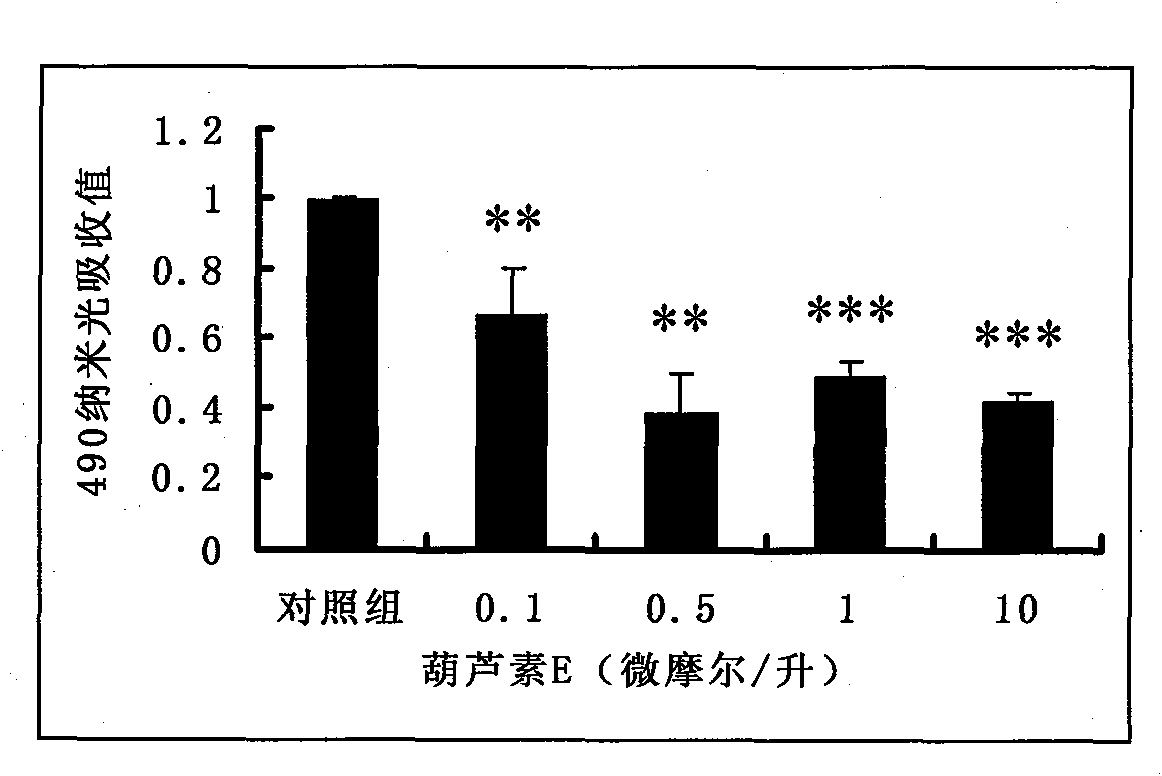Application of tetracyclic triterpenoids compound in preparing anti-angiogenic drugs
An angiogenesis and drug technology, applied in the field of application of cucurbitacin E in the preparation of anti-angiogenesis drugs, can solve the problems of lack of cucurbitacin E, etc.
- Summary
- Abstract
- Description
- Claims
- Application Information
AI Technical Summary
Problems solved by technology
Method used
Image
Examples
Embodiment 1
[0033] Example 1: Cucurbitacin E inhibits proliferation of endothelial cells
[0034] Purpose and principle: Cell proliferation experiment adopts MTS method. The MTS method is an assay that uses a colorimetric method to determine the number of cell proliferations in living cells. NADPH dehydrogenase converts MTS tetrazolium salt compound into a colored substance soluble in tissue culture fluid, and its color depth is highly correlated with the number of living cells of the cell line within a certain range. This model can be used to evaluate the effect of drugs on cell proliferation.
[0035] Method: inoculate a certain amount of endothelial cell suspension in a 96-well plate, add culture medium containing different concentrations of cucurbitacin E for 48-72 hours, then add 20 microliters of chromogen to each well, and incubate for 1-4 hours , Read the light absorbance value in each well at 490 nm on a microplate reader.
[0036] Results and evaluation: Compared with the con...
Embodiment 2
[0037] Example 2: Cucurbitacin E inhibits scratch migration of vascular endothelial cells in vitro
[0038] Purpose and principle: Cell migration test is also called in vitro scratch test. In this experiment, scratches were made on a single layer of endothelial cells at a certain density in the culture plate, observed under a microscope, and the migration of cells at the edge of the scratch to the scratch site was recorded to evaluate the effect of drugs on the migration ability of endothelial cells .
[0039] Method: Inoculate a certain number of cells in a 6-well plate, and when the cells grow to about 80%, draw a line in each well with a 1ml tip of a micropipette. Wash the dead cells with PBS, then add medium containing VEGF and different drug concentrations, and incubate in an incubator at 37°C for about 24 hours until the scratched area of the VEGF165 group is covered with cells.
[0040] Result and evaluation: observe and take pictures under the microscope, see the r...
Embodiment 3
[0041] Example 3: Cucurbitacin E inhibits the migration of vascular endothelial cells in a modified Boyden chamber
[0042]Purpose and principle: The chamber migration experiment of endothelial cells adopts Boyden chamber. The modified Boyden chamber is a kind of petri dish that can be inserted into the cell culture plate. The bottom layer has a polycarbonate filter membrane with a pore size of 8 μm. Under the induction of growth factors, the cells can permeate the side of the membrane and adhere to the medium containing high concentration of The other side of growth factors. This experiment can detect the effect of drugs on the ability of endothelial cells to resist migration.
[0043] Method: Add 0.1% gelatin to the 24-well plate and incubate at 37°C for 30 minutes, discard the gelatin, and wash three times with PBS. Add the endothelial cell medium containing 10% serum and VEGF165 to the 24-well plate in the lower part of the small chamber. Insert the cells into the small...
PUM
| Property | Measurement | Unit |
|---|---|---|
| Aperture | aaaaa | aaaaa |
Abstract
Description
Claims
Application Information
 Login to View More
Login to View More - R&D
- Intellectual Property
- Life Sciences
- Materials
- Tech Scout
- Unparalleled Data Quality
- Higher Quality Content
- 60% Fewer Hallucinations
Browse by: Latest US Patents, China's latest patents, Technical Efficacy Thesaurus, Application Domain, Technology Topic, Popular Technical Reports.
© 2025 PatSnap. All rights reserved.Legal|Privacy policy|Modern Slavery Act Transparency Statement|Sitemap|About US| Contact US: help@patsnap.com



